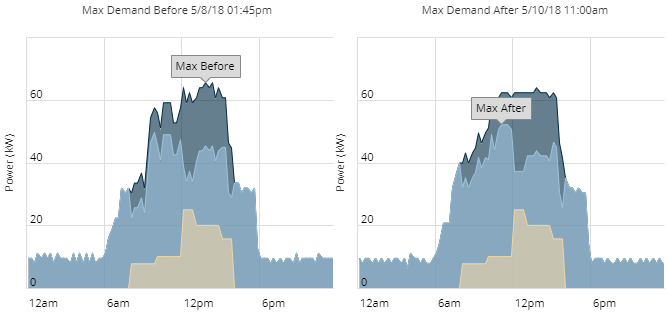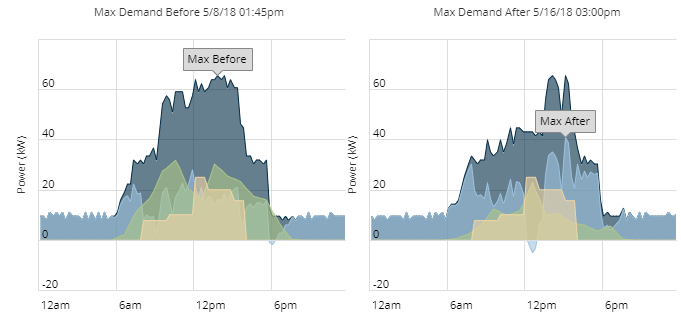Everyone is super excited about batteries. Rightfully so, because they can provide a lot of savings and insure your investments against future rate changes. Batteries accomplish this savings by reducing your monthly demand charges and discharging the solar energy later during the most expensive times. Before you install a battery, you should consider your energy efficiency options first because they will also provide you with demand and energy savings. Energy efficiency paired with solar and energy storage is like installing a larger battery at a lower cost.
The utilities charge you for your highest peak demand every month. This means the moment you were using the most electricity during any 15-minute interval. This is typically during the hottest days when a business is running their air conditioning while conducting business as usual. While a battery will do a good job to mitigate that demand spike, energy efficiency upgrades will bring down your demand down more cost effectively. Doing these upgrades will improve the performance of your battery as it can tackle the harder to curb demand spikes. The below example simulates demand reductions by an LED & HVAC upgrade.

LED: The Dumbest Battery
LED upgrades are simple with an incredibly quick payback. Lighting can represent a large portion of the electricity needs for offices and warehouses. Lighting is almost always on, especially when a business hits their peak demand. This means that replacing your lights with LEDs will reduce your demand automatically by that amount. It's not the cause of the demand, but it provides a reliable reduction. Improved lighting controls can help too, so you can reduce your demand and not light up unoccupied areas.
HVAC: The Dumb Demand Spike
For businesses without a lot of equipment, the peak demand is usually going to occur on the hottest day. This means that any efficiency upgrades to your HVAC equipment is going to reduce your demand during the hottest days of the year. HVAC is also typically used during mid and on peak periods, meaning any additional kWh reduction means better savings. Sometimes reducing your HVAC demand is a smarter controller that cycles each unit so they don't all turn on at the same time.
Insulation and Cool Roofs: The Dumb Cool Battery
Similar to the HVAC equipment, these upgrades will help your building during the hottest days of the year. The cool roof will reduce the temperature of your roof and reduce your cooling load. Insulation upgrades will mitigate the impacts of the outside temperature by keeping the building's indoor temperature more stable which let your HVAC system reduce its load. Insulation can be added to your roof, walls, and you can even improve your buildings' insulation with better windows.
Refrigeration: The Coolest, Least Dumb Battery
Many of our efficiency upgrades so far discussed do not relate as directly with to a business's operation as refrigeration. If a company installs inadequate refrigeration for their space, and a storage space goes above freezing temperatures, it could mean the loss of an entire's day work or losing all of your inventory. There are many ways to tackle your refrigeration energy use, but you have to be smart about it. This is why SunGreen has experienced partners that will help you reduce your energy usage and not sacrifice your business. These partners can help reduce your operating costs and can create tremendous savings when combined with solar and storage.

As you can see from the above example, when the efficiency upgrade is combined with a solar system, even on a cloudy day, the peak demand moves to another day. You can insure this shift by adding energy storage.
Dumb, but Not Easy Savings
Energy efficiency upgrades can be very hard to calculate though. The improvements are weather dependent and most buildings don't keep track of what devices are using electricity at what times. This makes it difficult to attribute savings to a particular upgrade except for LEDs if they are always on. For example, if you make big HVAC upgrades but the next year is the hottest on record, your electricity bill might still be pretty high, but it would've been even higher without the improvements.
This can make an energy storage upgrade more attractive as company's can calculate the performance of the battery against your historical usage and the solar's production. Some of these upgrades also include utility incentives and have a better payback than batteries, and if you do both, it will just help the battery provide you with more savings. This let's the battery focus on the loads that earn you money. A publishing company doesn't want to have fewer printers to achieve a lower demand because that means less profit. Many businesses can make this argument whether it be printer, plastic extrusion, or recycling. You're using that energy to make money.
You can learn more about the SunGreen process in our EBook






